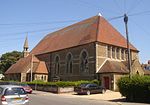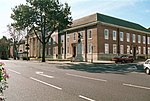Beach House Park, Worthing
1924 establishments in EnglandEngvarB from September 2017Parks and open spaces in West SussexSport in WorthingWorthing

Beach House Park is a formal garden in Worthing, a town and local government district in West Sussex, England. Opened by Worthing Borough Council in 1924, the 9.57-acre (3.87 ha) park has formal lawns and flowerbeds, bowling greens of international standard, and a war memorial commemorating war pigeons. A café in the grounds was destroyed by fire in 2009.
Excerpt from the Wikipedia article Beach House Park, Worthing (License: CC BY-SA 3.0, Authors, Images).Beach House Park, Worthing
Park Road,
Geographical coordinates (GPS) Address Nearby Places Show on map
Geographical coordinates (GPS)
| Latitude | Longitude |
|---|---|
| N 50.8136 ° | E -0.3633 ° |
Address
Park Road
BN11 2AS
England, United Kingdom
Open on Google Maps











